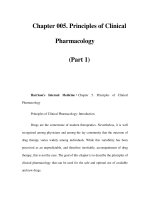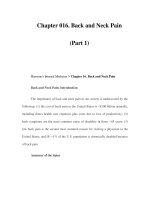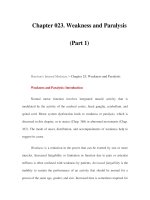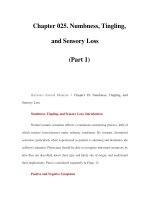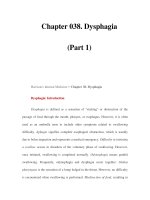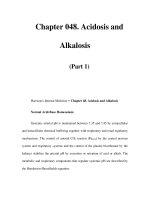Trauma Resuscitation - part 1 pps
Bạn đang xem bản rút gọn của tài liệu. Xem và tải ngay bản đầy đủ của tài liệu tại đây (839.21 KB, 37 trang )
Trauma Resuscitation
The team approach
Second Edition
Edited by:
Carl L.Gwinnutt MB BS FRCA
Consultant in Anaesthesia
Peter A.Driscoll BSc MD FFAEM
Consultant in Emergency Medicine
Hope Hospital, Manchester, UK
© BIOS Scientific Publishers Limited, 2003
First published © The Macmillian Press Limited 1993
This edition published in the Taylor & Francis e-Library, 2005.
“To purchase your own copy of this or any of Taylor & Francis or Routledge’s collection of thousands of eBooks please go to
www.eBookstore.tandf.co.uk.”
Second Edition © Bios Scientific Publishers Limited 2003
All rights reserved. No part of this book may be reproduced or transmitted, in
any form or by any means, without permission.
A CIP catalogue record for this book is available from the British Library.
ISBN 0-203-42785-8 Master e-book ISBN
ISBN 0-203-44151-6 (Adobe eReader Format)
ISBN 1 85996 009 X (Print Edition)
BIOS Scientific Publishers Ltd
9 Newtec Place, Magdalen Road, Oxford OX4 1RE, UK
Tel. +44 (0)1865 726286. Fax +44 (0)1865 246823
World Wide Web home page: />Production Editor: Andrew Watts
Contents
Contributors ix
Abbreviations xiii
Preface xvi
Trauma websites xviii
Introduction xx
1 Resuscitation and stabilization of the severely injured patient
P Driscoll, D Bates, G Lomas
1
Introduction 1
Pre-hospital information and communication 1
The trauma team 2
Preparation 5
Reception and transfer 6
Assessment and management 6
Preparation of the resuscitation room 24
Summary 24
2 The management of the airway and cervical spine
C Gwinnutt, O Goodall
26
Introduction 26
Anatomy 26
Standby preparation and transfer 26
Assessing and securing the airway 27
Breathing 30
Advanced airway control 31
Summary 51
3 Thoracic trauma 52
R Kishen, G Lomas
Introduction 52
Applied anatomy 52
Pathophysiology 55
Assessment and management 57
Secondary survey 66
Imaging and investigations in thoracic trauma 71
Other injuries in thoracic trauma 75
Summary 77
4 Shock
A McCluskey
78
Definition 78
Classification 78
Cardiovascular physiology 79
Cellular effects of shock 86
Causes of shock 87
Estimating volume loss and grading shock 88
Assessment and management of the shocked patient 91
Summary 100
Appendices 100
5 Abdominal and pelvis trauma
A Sen, M Scriven
106
Introduction 106
Applied anatomy 107
Mechanism of injury 115
Assessment and management 117
Summary 124
6 Head trauma
D Bryden, C Gwinnutt
125
Introduction 125
Anatomy 125
iv
Physiology 131
Signs of a head injury 133
Assessment and management 134
Terminology applied to head injuries 141
Referral to a neurosurgeon 143
Summary 145
7 Spinal injuries
P Kelly, P Johnson, C Gwinnutt
147
Epidemiology of spinal injury 147
Anatomy of vertebral column and spinal cord 148
Mechanism of injury 154
Assessment and management 157
Summary 168
8 Maxillofacial injuries
D Patton
169
Introduction 169
Applied anatomy 169
Assessment and management 172
Summary 183
Appendix 183
9 Soft tissue and extremity injury
G Andrew, L Light
186
Introduction 186
The pathophysiology of soft tissue and fracture healing 187
Clinical assessment of soft tissue injuries in the limbs 192
Simple wound closure 197
Extensive wounds 199
Specialized wounds 201
Fractures 202
Dislocations 212
Ligament injuries 213
v
Summary 214
Appendix 214
1
0
Psychological and psychiatric issues in the resuscitation room
D Alexander, S Klein
217
Introduction 217
Normal reactions to highly stressful and traumatic events 217
Psychological first aid 218
Acute psychiatric conditions 219
Post-traumatic stress disorder 222
Grief reactions 222
Dealing with the bereaved 224
Breaking bad news 225
Relatives in the resuscitation room 226
Summary 230
1
1
Trauma in the elderly
R Protheroe
232
Introduction 232
Epidemiology of injury 232
Anatomical and physiological changes 233
Assessment and management 236
Summary 239
1
2
Trauma in children
S Robinson, N Hewer
241
Introduction 241
Injury patterns in children 241
Preparation and equipment 245
Assessment and management 245
Summary 254
1
3
Trauma in pregnancy
S Fletcher, G Lomas
256
Introduction 256
The pathophysiology of pregnancy 256
vi
Assessment and management 258
Summary 264
1
4
Burn injury
A Kay, R Rickard
266
Introduction 266
Causes of burn injury 267
Pre-hospital approach to burn patient management 273
Accident and Emergency department management of the burn patient 276
Transfer to definitive care 284
1
5
Hypothermia and drowning
J Soar, C Johnson
288
Hypothermia 288
Definition 288
Pathophysiology 288
Diagnosis 289
Initial management of the hypothermic patient 291
Death and hypothermia 294
Drowning 294
Definitions 295
Aetiology 295
Pathophysiology of immersion and submersion 295
Rescue 296
Assessment and management 297
Summary 299
1
6
Pain relief after trauma
T Johnson, J Windle
300
Introduction 300
Physiology of the experience of pain 300
Clinical management of pain 302
Analgesia for difficult conditions 314
Progression to chronic pain 314
vii
Summary 316
1
7
Inter- and intra-hospital transfer of the trauma patient
K Lennon, S Davies, P Oakley
318
Introduction 318
Indications for secondary transfer 318
Transfer team composition 320
Equipment and drugs 321
The five phases of inter-hospital transfer 322
Summary 330
Index 332
viii
Contributors
Professor David Alexander
Aberdeen Centre for Trauma Research
Bennachie
Royal Cornhill Hospital
Aberdeen
Glynne Andrew
Consultant and Honorary Senior Lecturer in Trauma and Orthopaedic Surgery
Hope Hospital
Salford
Damien Bates
Specialist Registrar
Department of Emergency Medicine
Hope Hospital
Salford
Danny Bryden
Consultant in Anaesthesia and Intensive Care Medicine
Royal Hallamshire Hospital
Sheffield
Simon Davies
Trauma Nurse Coordinator
North Staffordshire Hospital
Stoke-on-Trent
Peter Driscoll
Consultant and Honorary Senior Lecturer in Emergency Medicine
Hope Hospital
Salford
Susan Fletcher
Consultant Anaesthetist
Hope Hospital
Salford
Olive Goodall
Lead Nurse
Department of Emergency Medicine
Hope Hospital
Salford
Carl Gwinnutt
Consultant Anaesthetist
Hope Hospital
Salford
Nicola Hewer
Sister
Department of Emergency Medicine
Addenbrooke’s Hospital
Cambridge
Chris Johnson
Consultant Anaesthetist
Southmead Hospital
Bristol
Philip Johnson
Charge Nurse
Department of Emergency Medicine
Hope Hospital
Salford
Tim Johnson
Consultant in Pain Management and Anaesthesia
Hope Hospital
Salford
Alan Kay
Consultant Plastic and Reconstructive Surgeon
Frenchay Hospital
Bristol
Peter Kelly
Consultant in Emergency Medicine
The Lister Hospital
Stevenage
Hertfordshire
Roop Kishen
Consultant in Anaesthesia and Intensive Care Medicine
x
Hope Hospital
Salford
Susan Klein
Thompson Research Fellow in Psychotherapy
Research Coordinator
Aberdeen Centre for Trauma Research
Bennachie
Royal Cornhill Hospital
Aberdeen
Kieran Lennox
Consultant in Anaesthesia and Intensive Care Medicine
North Staffordshire Hospital
Stoke-on-Trent
Lesley Light
Lead Nurse
Department of Trauma and Orthopaedics
Yeoville District Hospital
Somerset
Gabby Lomas
Senior Nurse Practitioner
Department of Emergency Medicine
Hope Hospital
Salford
Anthony McCluskey
Consultant in Anaesthesia and Intensive Care Medicine
Stepping Hill Hospital
Stockport
Peter Oakley
Consultant in Anaesthesia and Trauma
North Staffordshire Hospital
Stoke-on-Trent
David Patton
Consultant and Honorary Senior Lecturer in Maxillofacial Surgery
Morriston Hospital
Swansea
Richard Protheroe
Consultant in Anaesthesia and Intensive Care Medicine
Hope Hospital
Salford
xi
Rory Rickard
Specialist Registrar
Department of Plastic and Reconstructive Surgery
Frenchay Hospital
Bristol
Susan Robinson
Consultant in Emergency Medicine
Addenbrooke’s Hospital
Cambridge
Mark Scriven
Consultant General and Vascular Surgeon
Maelor Hospital
Wrexham
Aruni Sen
Consultant in Emergency Medicine
Maelor Hospital
Wrexham
Jasmeet Soar
Consultant in Anaesthesia and Intensive Care Medicine
Southmead Hospital
Bristol
Jill Windle
Lecturer Practitioner
Department of Emergency Medicine
Hope Hospital
Salford
xii
Abbreviations
ABG Arterial blood gases
ADH Anti-diuretic hormone
AP Anterioposterior
APLS Advanced paediatric life support
ARDS Acute respiratory distress syndrome
ASA American Society of Anesthesiologists
ATNC Advanced Trauma Nursing Course
ATLS Advanced trauma life support
BAT Blunt abdominal trauma
CI Cardiac index
CK Creatinine kinase
CO Cardiac output
COX Cyclo-oxygenase
CPAP Continuous positive airway pressure
CPP Cerebral perfusion pressure
CPR Cardiopulmonary resuscitation
CRPS Complex regional pain syndrome
CSF Cerebrospinal fluid
CT Computerized tomography
CVP Cerebral venous pressure
DAI Diffuse axonal injury
DIC Disseminated intravascular coagulation
DIP Distal interphalangeal
DPL Diagnostic peritoneal lavage
DT Delirium tremens
ECG Electrocardiography
ED Emergency Department
EDH Extradural haematoma
ERCP Endoscopic retrograde cholangio-pancreatography
FAST Focused abdominal sonography for trauma
FBC Full blood count
FDP Flexor digitorum profundus
FDS Flexor digitorum superficialis
GCS Glasgow Coma Scale
GP General Practitioner
GSW Gunshot wound
HDU High dependency unit
HPPF Human plasma protein fraction
IABP Intra-aortic balloon pump
ICH Intracerebral haematoma
ICP Intracranial pressure
ICU Intensive care unit
IDH Intradural haematoma
ISS Injury severity score
iv Intravenous
IVP Intravenous pressure
JVP jugular venous pressure
KE Kinetic energy
LMA Laryngeal mask airway
LSP Life-saving procedures
LV Left ventricular
LVEDP Left ventricular end diastolic pressure
MAP Mean arterial pressure
MILS Manual inline stabilization
MODS Multiple organ dysfunction syndrome
MOF Multiple organ failure
MRC Medical research council
MRI Magnetic resonance imaging
MTOS Major Trauma Outcome Study
NAI Non-accidental injury
NSAID Non-steroidal anti inflammatory drug
OER Oxygen extraction ratio
PA Posterioanterior
PAC Pulmonary artery catheter
PAFC Pulmonary artery flotation catheter
PAOP Pulmonary artery occlusion pressure
xiv
PAT Penetrating abdominal trauma
PCA Patient controlled analgesia
PICU Paediatric intensive care unit
PIP Proximal interphalangeal
PTSD Post traumatic stress disorder
PVR Pulmonary vascular resistance
ROSPA Royal Society for the Prevention of Accidents
RSD Reflex sympathectomy dystrophy
RSI Rapid sequence induction
RTA Road traffic accident
RTS Revised trauma score
RVEDP Right ventricular end diastolic pressure
SCI Spinal cord injury
SCIWORA Spinal cord injury without radiological abnormalities
SDH Subdural haematoma
SV Stroke volume
SVR Systemic vascular resistance
TARN Trauma Audit Research Network
TNCC Trauma Nursing Care Course
TOE Transoesophageal echocardiography
TTE Transthoracic echocardiography
VAD Ventricular assistance device
VF Ventricular failure
xv
Preface
The evolution of trauma care in developed countries around the world has created new and exciting roles
for all the personnel involved in the resuscitation and recovery of critically injured patients. The stress on
strict roles for the nurse, doctor, paramedic and ancillary staff is now being replaced by a greater emphasis
on the ‘team approach’. This acknowledges the interactive nature of the procedures undertaken by the trauma
team and the need for close cooperation at all stages of the resuscitation. It is an approach at its most
successful when based on a formally organized team structure whereby tasks and roles are allocated
appropriately. This enables procedures to be undertaken simultaneously, thereby reducing resuscitation
times. In addition, it puts each member of the trauma team in the position of being responsible for
evaluating the patient and the situation, anticipating the next most appropriate action even as one is being
performed, and communicating with each member of the team to provide the best care.
This book has been created with this new vision of the multi-member trauma team in mind. The objective
of the authors is to present a comprehensive view of trauma management and its sequelae that relates to
both doctors and nurses involved with trauma resuscitation. The general approach to the clinical
management of the patient is similar to that espoused by the internationally recognized Advanced Trauma Life
Support Course (ATLS), the Advanced Trauma Nursing Course (ATNC) and the Trauma Nursing Core
Course (TNCC).
In addressing both doctors and nurses, the book emphasizes the importance of all personnel involved
having a good understanding of the pathophysiological changes underlying a trauma resuscitation. This
enables greater cooperation between personnel and facilitates the anticipation of the patient’s needs.
Consideration is therefore given to the relevant mechanisms of injury, the physiological response to injury
and a practical system of identifying and addressing life-threatening conditions. Trauma care is reviewed in
a systematic way, body system by body system. In addition, in the chapters concerned with areas where injury
is commonly life threatening, particular attention is paid to the applied anatomy and physiology of the
normal system. Following this, the pathophysiological changes due to trauma and the clinical management
of these patients is reviewed.
For further information, the interested reader is referred to the section at the end of each chapter. This
lists both medical nursing literature which can be used to follow up on particular aspects of trauma care. We
are also aware that protocols evolve in the life-time of a book as further evidence becomes available. To
cope with this a list of key websites are also listed so that topic updates can be easily obtained.
No attempt has been made to highlight either the nurses’ or doctors’ allocated tasks since the aim of the
book is to emphasize the need for an integrated team approach. At certain points in the text however, the
nurses’ role has been stressed and technical procedures which, in the UK, would be mainly undertaken by
doctors, have been highlighted for easy reference. The extent to which nurses and doctors carry out
particular tasks will depend on training and local policy. With limitations in medical personnel, as seen in many
countries, the trauma nurse could be expected to take over more of the doctor’s role. In all situations
though, the philosophy of the trauma team should be understood by all members, so that consistent good
care can be achieved.
The authors recognize that trauma care is delivered in an expansive variety of settings. It is our desire to
equip all personnel, no matter what environment in which he/she practises, with information that can assist
them in developing the appropriate decision-making skills required in managing the injured patient. We are
confident that Trauma Resuscitation: The Team Approach will help all carers to reach their potential as
members of the trauma team and, by doing so, improve the patient’s chances of returning to a full and active
life.
Carl L Gwinnutt
Peter A Driscoll
xvii
Trauma websites
All the chapters in this book are referenced with websites that provide further information on the subject.
There are millions of websites on the internet and these vary hugely in quality and accuracy. Below are a
few simple rules to follow when using websites.
The easiest way to find information on the web is by using a search engine and typing in key words.
Different search engines have different ways of finding sites so they will not all give the same results.
The main search engine used for this book was Google. At the end of each chapter there is a list of key words
that may help you with your search. Some search engines are listed below:
www.google.com
www.yahoo.com
www.altavista.com
www.ask.co.uk
Some websites act as portals to other sites. They have usually chosen a list of useful links to websites
covering particular topics. Hopefully these sites have been vetted for quality and accuracy.
Accuracy. Much of the information on the web has not been peer reviewed and may have been put on the
web several years ago. A degree of judgement is usually required when looking at the site. Questions to
ask include who wrote the site and is the site dated? Many sites are produced by professional
associations and universities and tend to be of good quality; others are put together by individual
enthusiasts and quality can vary immensely. Some sites are updated regularly while many languish in the
past.
Ease of use. Some complex sites may take a long time to download depending on the type of connection
you use. Large images may also be slow to download. All the sites recommended are relatively
straightforward to download from the web.
Journals. Many journals are now available online. Whilst some are free, most require a subscriptions. The
library in your hospital or university may have electronic subscriptions to journals. Your librarian should
be able to assist you in obtaining access to journals online, by providing you with passwords for those
journals the library has a subscription for.
Each chapter is followed by a list of sites that are specific to that subject. The sites listed below are general
websites that cover a number of trauma topics. All the sites we have listed are free.
www.trauma.org
This is an excellent trauma website which includes interactive moulages.
/>This is the trauma website of the Liverpool Hospital, Sydney, Australia. It has some useful sections on all
aspects of trauma.
www.bestbets.org
Provides evidence-based answers to common clinical questions, using a systematic approach to reviewing
the literature.
www.cdc.gov/ncipc/default.htm
US national injury prevention homepage: full of useful facts and figures and prevention issues.
www.update-software.com/ccweb/cochrane/revabstr/mainindex.htm
This site provides abstracts to the Cochrane database of evidence-based reviews.
/>This site gives a list of the journals that are currently freely available on the internet. This includes many
trauma journals.
www.ncbi.nlm.nih.gov/entrez/query.fcgi
PubMed, a service of the National Library of Medicine, provides access to over 11 million MEDLINE
citations back to the mid-1960s and additional life science journals. PubMed includes links to many sites
providing full text articles and other related resources.
/>This is the WHO website containing international data on cause of death including trauma statistics.
www.cdc.gov/ncipc/default.htm
US national injury prevention homepage: full of useful facts and figures and prevention issues.
Jas Soar
xix
Introduction
P.A.Driscoll
What is the size and extent of the problem?
The world is currently waging a war on its streets, in the work place and at home. At the start of this
millennium the number of trauma deaths exceeded 3.2 million worldwide. In the UK alone, the annual
number of deaths from trauma is 14.5—18,000, but the USA can boast a figure approximately ten times
greater. Each day 3 thousand die and 30 thousand are seriously injured on the world’s roads. Developing
countries are reporting similar findings as road traffic crashes begin to exceed deaths due to infectious
diseases. 85% of the deaths and 90% of the disability adjusted life years lost from road traffic crashes are in
the low and middle-income countries. As in all wars, it is the youth of the country that takes the heaviest
losses. It remains the most common cause of death in industrialized nations, in people under 35. However
by 2020 it is anticipated that trauma will be the second or third leading cause of death in all countries.
Disability from trauma far exceeds the number of fatalities. For example 31 people in Portugal sustain
some disability for every vehicular death and in the USA there are 19.4 million non-fatal injuries per annum
(i.e. one every 2 seconds). Overall, casualties from this ‘trauma war’ occupy more hospital beds and cause
the loss of more working days, than cancer and cardiac patients combined. For the British taxpayer, the cost
of this slaughter is high—£2.22 billion per annum, i.e., around 1% of the gross national product (WHO
estimation). In the USA, the figure is put at $400 billion. The final cost is even higher because there is a loss
of national talent and tax revenue, in addition to the emotional and material consequences suffered by each
family affected. The cumulative effect of trauma patients who survive, but in a crippled state, adds to the
financial pressure.
What areas of the body are being injured?
Trauma is usually caused by a blunt mechanism in the developed world. This leads to multiple injuries, with
usually one system severely affected and one-to-two others areas damaged to a lesser degree. Overall, the
incidence of life threatening injuries in different systems is: head 30–70%, chest 20–35%, abdomen 10–35%
and spine 5%. In excess of 40% of the trauma victims also have orthopaedic injuries but these are not
usually life threatening.
When is death following trauma occurring?
In 1983, Trunkey’s group at San Francisco General hospital reviewed 862 trauma deaths over a 2-year
period. They concluded the fatalities occurred in one of three phases. The first peak is at, or shortly after,
the time of injury. These patients die of major neurological or vascular injury and most are unsalvageable
with present day technology but 40% could be avoided by various prevention programmes. UK data would
support this conclusion.
In the US data, the second peak occurred several hours after the injury. These patients commonly die from
airway, breathing or circulatory problems. The majority of these cases are potentially treatable. This period
has become known as the ‘golden hour’ to emphasize the time following injury when resuscitation and
stabilization are critical. UK data does not show a specific peak in this time frame. In England and Wales
there is a steady fall off in the death rate over time. In contrast in Scotland there are very few deaths until
the “third peak” described below.
This final peak in the US data occurs days or weeks after the injury. These victims are dying from
multiple organ failure, acute respiratory disease syndrome or overwhelming infection. It is now known that
inadequate resuscitation in the immediate or early post injury period leads to an increased mortality rate
during this phase.
Is trauma care getting better in the UK?
In 1988, a Royal College of Surgeons’ investigation on 11 health districts in England and Wales found that
a third of the trauma deaths, occurring after arrival in hospital, were preventable. These deaths resulted from
missed diagnosis, hypoxia, continuing haemorrhage and lack of timely surgery.
Lecky et al summarised the progress made by 2001. They found there had been a 3% reduction in the
overall severity adjusted odds of death in England and Wales. Of interest was that most of this improvement
occurred before 1994 and appeared to correspond to the increase in consultant presence in the initial
management of severely injured patients (i.e., ISS over 15) (25% in 1989 to 40% in 1994). There was also a
rapid spread of the advanced trauma courses (e.g., ATLS, TNCC, ATNC). After 1994, the mortality rate has
remained steady with the best 10% of hospitals having a standardised mortality rate difference of 85
compared to the bottom 10%.
It is not clear why progress has stopped. One possibility is that the UK never took on board the
development of whole trauma systems as advocated in North America. Consequently they go to the nearest
hospital rather than the most appropriate. Furthermore, within the receiving hospital itself the organised
trauma care found in many resuscitation rooms may not continue once the patient goes to theatre or the
ward.
Are there problems with the current system of managing the trauma victims in the
UK?
Prevention
There are few cases that are true ‘accidents’, i.e., “an event without apparent cause”. For example, the man
who crashes his car after drinking alcohol has not had an accident. All traumatic events are an interaction
between host, agent, social culture and the legal system. The Transport and Road Research Laboratory
(UK) estimates that 65% of road traffic “accidents” were due to human error. 80% of the pedestrians injured
were themselves at fault, with children and the elderly being the worst offenders.
The link between alcohol abuse and many types of injury has been well documented. In the UK it is a
factor in at least 28% of all fatal car crashes, and in the USA, 40–50% of the people dying following trauma
have a blood alcohol level greater than 100 mg%. Alcohol can also influence the clinical course of the
xxi
patient by affecting the diagnostic signs and physiological and immunological response to trauma.
Compared to alcohol, other drugs cause fewer road traffic crashes. Nevertheless the incidence of
prescription and illegal substances being found in road users is increasing.
Prevention by legislation has been used effectively in various countries over the past years, with laws on
smoke alarms, flame resistant clothing, drink/driving, seat belts, child car seats, car design and motorcycle
helmets being introduced. Education has also been used to some effect. Unfortunately, trauma, like all
diseases, is more common in the socially deprived and would be improved by material changes in the social
conditions.
Prehospital care
The standard of care in the pre-hospital phase varies significantly between countries as well as between
districts inside the same country. Studies from the UK have shown an increase in pre-hospital time over the
years. This is likely to be due to the increase in the use of advanced skills by paramedics. Unfortunately this
increase in expertise is not matched by an increase in survivors. Indeed there is evidence to show that using
advanced skills in the critically ill patient increases their chance of dying. It would appear these patients
need to rapidly transported to an appropriate facility where anaesthetic or surgical intervention can be
carried out quickly. In contrast patients who are haemodynamically stable do benefit from advanced care at
the scene of the incident and go onto have lower disability scores once they leave hospital. What is required
therefore are trained paramedics who can judge when to intervene and when to move. Unfortunately the
current UK paramedic receives little audit and feedback on their management of the patients and so there is
no accumulation of knowledge and experience. This situation is perpetuated by there being little medical
input into the service and the very limited communications between the hospital and the on site team. The
result is a profession that is not utilizing its post training learning experiences.
On Admission
In Briton, trauma victims frequently arrive late at night when inexperienced junior doctors staff the
Emergency departments. This can lead to delays in getting senior help once the clinician realizes there is a
problem. There are also difficulties in carrying out necessary investigations and prioritising patients’
injuries. Delays in carrying out the life saving procedures (LSP) have to be prevented as this has a strong
(negative) correlation with physiological changes in the patient in the resuscitation room. The time for the
LSP also affects the overall survival of the trauma patient.
Trauma teams are not exclusive to Trauma Centres. Indeed many District General hospitals (or their
equivalent in Europe and the USA) have such teams. This has the theoretical advantage of bringing together
a group of people with the appropriate expertise to manage the multiply injured patient. In the UK, the
teams usually comprise junior doctors with limited experience in handling the complex problem of trauma
management. The organization of the teams is informal with members arriving at different times and
carrying out procedures in an ad hoc manner. There is no overall co-ordination and no allocation of duties to
the team members. There is also no national guidance on the organization of the ideal trauma team, its
structure and who should be in charge.
Once resuscitation starts the next problem encountered is the poor knowledge base for the management
of the pathophysiological changes after trauma. Reliance is put on clinical skills and inadequate monitoring
devices recording variables such as blood pressure and heart rate. This leads to lesser degrees of hypoxia
and hypovolaemia not being recognized, resulting in too little oxygen and fluid being given too late. It is
xxii
therefore not surprising that hypoxia and hypovolaemia are the chief causes of preventable death in
industrialized nations.
The role of the team in trauma care
It can be seen from the previous discussion that there is considerable scope for improvement in all aspects
of trauma care. A fully integrated team of trained nurses and doctors needs to be present to deal with the
trauma victim when he arrives at the hospital. An efficient, organized resuscitation needs to be commenced
which leads to initial stabilization, diagnosis and definitive management.
It has been shown that the most efficient team organization is achieved by having each team member
carrying out individual tasks simultaneously. This process is known as ‘horizontal organization’. The least
efficient technique in which each task is carried out sequentially, is known as Vertical organization. If tasks
are to be performed simultaneously, precise allocation of tasks to team members is essential, or there is
chaos. Each procedure is divided into manageable units and allocated to individual team members by a
designated nursing and medical team leader. These tasks must be divided evenly among the team to prevent
overloading of any particular member.
When these organizational changes are introduced significant reductions in resuscitation times can be
achieved. In particular, the time to carry out the life saving procedures is shortened and this is known to
correlate with the short and long term survival of the patient.
The initial management of the trauma victim can be a difficult and stressful time, which could easily
become overwhelming without prior planning. The allocation of staff to specific roles within the team,
relieves the stress and ensures that the department functions safely, whilst the injured patient receives
immediate assessment and life saving intervention.
To enable these organizational changes to be introduced, the team members have to have the skills to
carry out the particular tasks. A key way of achieving this is by having all the staff dealing with trauma
victims, complete an Advanced Trauma course. To this should be added specific training in team work and
leadership so that the group functions as a unit rather than collection of individuals with no common aim.
This certainly should be the aim for the future. Until this is achieved however, the necessary organizational
changes required for the team approach can still be made with appropriate departmental or hospital training.
The following chapters provide information on which these changes can be based. For those who have
already completed the above courses, the following chapters will act to reinforce the knowledge and skills
acquired and hopefully act as a spurt to encourage others to undertake similar training.
References and further reading
Anderson I, Woodford M, De Dombal F et al. Retrospective analysis of 1000 deaths from injury in England and
Wales. BMJ 1988; 296:1305–8.
Anderson I, Woodford M, Irving M. Preventability of death from penetrating injury in England and Wales. Injury
1989; 20:69–71.ATLS for doctors, Course manual. 6
th
Edition. The American College of Surgeons Committee on
Trauma, The American College of Surgeons, 1997, Chicago.
Boyd C, Tolson M. Evaluating trauma care: the TRISS method. J Trauma 1987; 27:370–378.Committee on trauma.
Hospital and prehospital resources for optimal care of the injured patient. Am C Surgeons Bull 1986; 71.
Driscoll P, Vincent C. Variation in trauma resuscitation and its effects on outcome. Injury 1992; 23:111–115.
Driscoll P, Vincent C. Organizing an efficient trauma team. Injury 1992; 23:107–110.
Driscoll P. Trauma: today’s problems, tomorrows answer. Injury 1992; 23:151–158.
xxiii
Lecky F, Woodford M, Bouamra O, Yates D. Lack of change in trauma care in England and Wales since 1994. EMJ
2002; 19:520–23.
Lecky F, Woodford M, Yates D. Trends in trauma care in England and Wales 1989–97. Lancet 2000; 355:1771–5.
Nantulya V, Reich M. The neglected epidemic: road traffic injuries in developing countries. BMJ 2002; 324:1139–41.
Nicholl J, Hughes S, Dixon S, Yates D. The costs and benefits of paramedic skills in pre-hospital trauma care. HMSO
1998, London.
Roberts I, Abbasi K. War on the roads. BMJ 2002; 324:1107–8
Royal College of Surgeons Report. The management of patients with major injuries. Report of a Working Party 1988;
Royal College of Surgeons, London.TNCC Course manual (second edition). Emergency Nurses Association 1988,
Award Printing Corporation, Chicago, Illinois.
Trunkey D. Trauma. Scientific America 1983; 249:28–35
West J, Trunkey D. Systems of trauma care: a study of two counties. Arch Surg 1979; 114: 455–460.
Wyatt J, Beard D, Gray A, Busuttil A, Robertson C. The time of death after trauma. BMJ 1995; 310:1502.
xxiv

